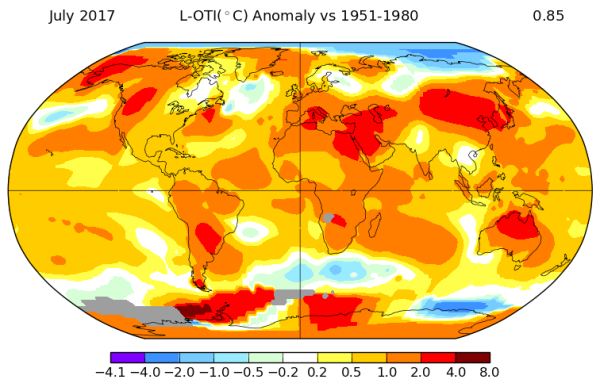No El Nino, But July of 2017 was the Hottest on Record. So What the Hell is Going on?
16
August, 2017
According
to NASA’s
GISS global temperature monitoring service,
July of 2017 was 0.83 C hotter than the NASA 20th Century baseline
(1.05 C hotter than 1880s). That’s the hottest July ever recorded
in the 137 year global climate record.
In
the Pacific, ENSO
conditions remain neutral.
And since 2014-2016 featured one of the strongest El Ninos on record,
you’d expect global temperatures to back off a bit from what should
have been a big spike in the larger warming trend. So what happened?
(Top
image shows July of 2017 global temperature anomalies compared to
July of 2016 global temperature anomalies [bottom image]. July of
2016 was cooling into a weak La Nina relative to one of the strongest
El Ninos on record. This year, ENSO neutral conditions prevail
coordinate with rather strong polar amplification in the Southern
Hemisphere as temperatures in the Southern Ocean off West Antarctica
hit an 8 C warm temperature anomaly [!!]. Images provided by NASA
GISS.)
During
July of 2016, the world was backing away from a very strong El Nino
and heading into the mild global temperature trough of a weak La
Nina. Cooler conditions in the Equatorial Pacific were starting to
put a bit of a damper on the extreme global temperature departures
that, earlier in the year, hit
as high as 1.55 C above 1880s averages during February.
The
La Nina lag during July of 2016 was enough to pull global surface
temperatures down to 1.04 C above 1880s averages. However, the added
heat pumped out into the system by both fossil fuel produced
greenhouse gasses and the shift to strong El Nino appears to have
generated a step change in the global temperature regime. So despite
a weak La Nina dominating during fall of 2016, global temperatures
remained in a range of 1.06 to 1.21 C above 1880s averages during
August through December.
2017
Still Trending Toward Second Hottest on Record
Moving
into 2017, overall global temperatures have backed off from the
extreme heat seen during 2016. But only a little.
Adding
in the record hot July at
1.05 C above 1880s averages,
we find that 2017, so far is 1.16 C hotter than 1880s overall for the
first seven months. That’s just 0.05 C shy of the record global
heat that appeared in 2016. Not really much of a back-off at all.
July’s
own record wasn’t a very impressive warm departure from 2016 —
beating it by just 0.01 C. But what it does reveal is that there is
an extraordinary amount of heat roaming the surface airs and waters
of our world. And since all that extra heat will tend to resist
cooling into Northern Hemisphere winter as it transfers poleward, we
can probably expect that relative temperature anomalies will again
rise as we move away from Northern Hemisphere summer. With departures
likely continuing to exceed 1.05 or even 1.1 C above 1880s for most
months going forward.
Already, early
GFS model runs indicate that August of 2017 will likely be warmer
than July.
And this month might even come close to challenging the 1.21 C above
1880s averages achieved during 2016. However, using GFS global
averages as an indicator is not a perfect oracle. So we wait on the
August numbers from GISS and NOAA a month from now for final
confirmation.
Furthermore, we
do have a relatively weak cool Kelvin wave rippling along beneath the
Equatorial Pacific at
this time. This wave should shift the ENSO pattern to the cool side
of neutral by Northern Hemisphere fall. A pattern that should also
tend to nudge overall global temperatures downward. Recent falls in
the north, though, have tended to exhibit very extreme polar warming.
And a similar trend this year would tend to offset any Pacific
Equatorial cooling. Lastly, the cooler ENSO neutral pattern is likely
to still be a warmer general forcing than the weak La Nina that
appeared during late 2016. So there is at least some potential that
some months during fall of 2017 will be warmer than those during fall
of 2016.
Considering
these trends, the best available predictive analysis from NASA shows
that 2017 is likely to be about 1.1 C warmer than 1880s or the second
hottest year on record globally overall. NASA’s Gavin Schmidt gives
this range a 77 percent likelihood of bearing out. But note the error
bar in Gavin Schmidt’s above tweet. In other words, the presently
far more unstable climate appears to be quite capable of serving up
some relatively nasty surprises.
Links:
Hat
tip to Redsky
Hat
tip to Joe
Romm





No comments:
Post a Comment
Note: only a member of this blog may post a comment.